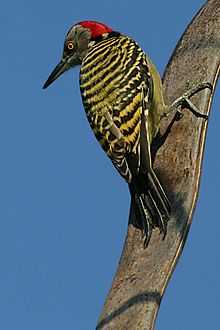Hispaniolan Woodpecker
From Wikipedia, the free encyclopedia
| Hispaniolan Woodpecker | |
|---|---|
 | |
| Conservation status | |
| Scientific classification | |
| Kingdom: | Animalia |
| Phylum: | Chordata |
| Class: | Aves |
| Order: | Piciformes |
| Family: | Picidae |
| Subfamily: | Picinae |
| Genus: | Melanerpes |
| Species: | M. striatus |
| Binomial name | |
| Melanerpes striatus (Statius Muller, 1776) | |
The Hispaniolan Woodpecker (Melanerpes striatus) is a medium-sized woodpecker endemic to the Caribbean island of Hispaniola.
Their back is covered in yellow and black stripes. Males have a dark red stripe from their forehead to their neck while females the red stripe extends from the nape to the neck only. Their tail base is brilliantly red while the tail itself is black. The rump is olive-grey.
Unlike most woodpeckers, the Hispaniolan Woodpecker is a social species that takes advantage of having a large number of individual adult birds in the colony to protect a nesting bank or tree.
Their habitat, which is restricted to Haiti and the Dominican Republic, extends from the coasts, over the deserts to the mountains of the island.
References
- ↑ BirdLife International (2012). "Melanerpes striatus". IUCN Red List of Threatened Species. Version 2013.2. International Union for Conservation of Nature. Retrieved 26 November 2013.
Further reading
| Wikimedia Commons has media related to Melanerpes striatus. |
- Short, LL (1979). "Burdens of the picid hole-excavating habit". Wilson Bulletin 91 (1): 16–28.
- Hispaniolan Woodpecker videos on the Internet Bird Collection
- Stamps (for Dominican Republic-(2), Haiti)
- Hispaniolan Woodpecker photo gallery VIREO Photo-High Res-(Close-up)
This article is issued from Wikipedia. The text is available under the Creative Commons Attribution/Share Alike; additional terms may apply for the media files.
